Beelink GTR7 mini-PC Review: A Complete AMD Phoenix Package at 65W
by Ganesh T S on August 24, 2023 8:00 AM ESTSystem Performance: Multi-Tasking
One of the key drivers of advancements in computing systems is multi-tasking. On mobile devices, this is quite lightweight - cases such as background email checks while the user is playing a mobile game are quite common. Towards optimizing user experience in those types of scenarios, mobile SoC manufacturers started integrating heterogenous CPU cores - some with high performance for demanding workloads, while others were frugal in terms of both power consumption / die area and performance. This trend is now slowly making its way into the desktop PC space.
Multi-tasking in typical PC usage is much more demanding compared to phones and tablets. Desktop OSes allow users to launch and utilize a large number of demanding programs simultaneously. Responsiveness is dictated largely by the OS scheduler allowing different tasks to move to the background. The processor is required to work closely with the OS thread scheduler to optimize performance in these cases. Keeping these aspects in mind, the evaluation of multi-tasking performance is an interesting subject to tackle.
We have augmented our systems benchmarking suite to quantitatively analyze the multi-tasking performance of various platforms. The evaluation involves triggering a ffmpeg transcoding task to transform 1716 3840x1714 frames encoded as a 24fps AVC video (Blender Project's 'Tears of Steel' 4K version) into a 1080p HEVC version in a loop. The transcoding rate is monitored continuously. One complete transcoding pass is allowed to complete before starting the first multi-tasking workload - the PCMark 10 Extended bench suite. A comparative view of the PCMark 10 scores for various scenarios is presented in the graphs below. Also available for concurrent viewing are scores in the normal case where the benchmark was processed without any concurrent load, and a graph presenting the loss in performance.
| UL PCMark 10 Load Testing - Digital Content Creation Scores | |||
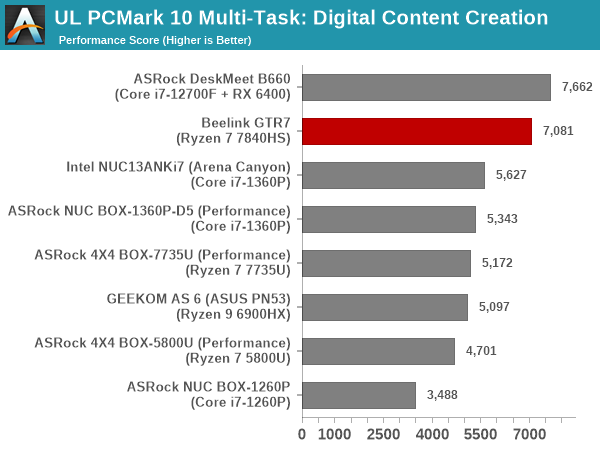
| UL PCMark 10 Load Testing - Productivity Scores | |||
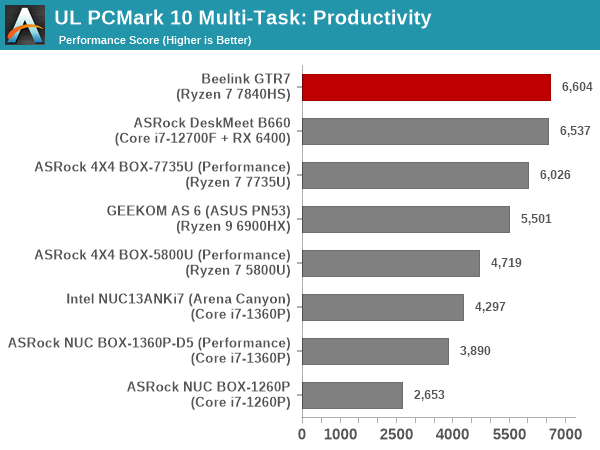
| UL PCMark 10 Load Testing - Essentials Scores | |||
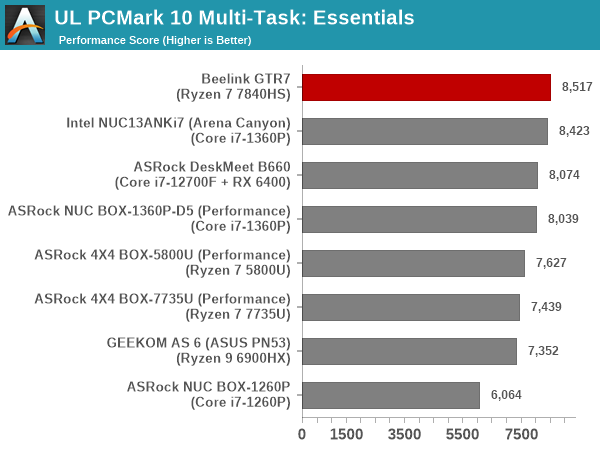
| UL PCMark 10 Load Testing - Gaming Scores | |||

| UL PCMark 10 Load Testing - Overall Scores | |||

Configuring the GTR7's Phoenix SoC at 65W gives it plenty of headroom to tackle multiple concurrent demanding workloads triggered by mainstream users (of the type benchmarked by PCMark 10). The GTR7 was already having leading performance in the absence of concurrent loading. Activation of such loads reduces the raw score, but the performance loss is less than the competition, and the GTR7 continues to remain on top.
Following the completion of the PCMark 10 benchmark, a short delay is introduced prior to the processing of Principled Technologies WebXPRT4 on MS Edge. Similar to the PCMark 10 results presentation, the graph below show the scores recorded with the transcoding load active. Available for comparison are the dedicated CPU power scores and a measure of the performance loss.
| Principled Technologies WebXPRT4 Load Testing Scores (MS Edge) | |||
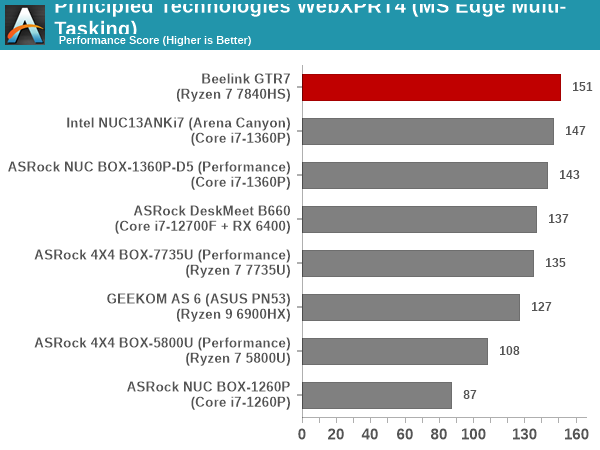
The observations made for the overall PCMark 10 scores continue to hold for WebXPRT 4 also. The GTR7 has the least performance loss, and that allows it to leapfrog the RPL-P systems in performance.
The final workload tested as part of the multitasking evaluation routine is CINEBENCH R23.
| 3D Rendering - CINEBENCH R23 Load Testing - Single Thread Score | |||

| 3D Rendering - CINEBENCH R23 Load Testing - Multiple Thread Score | |||
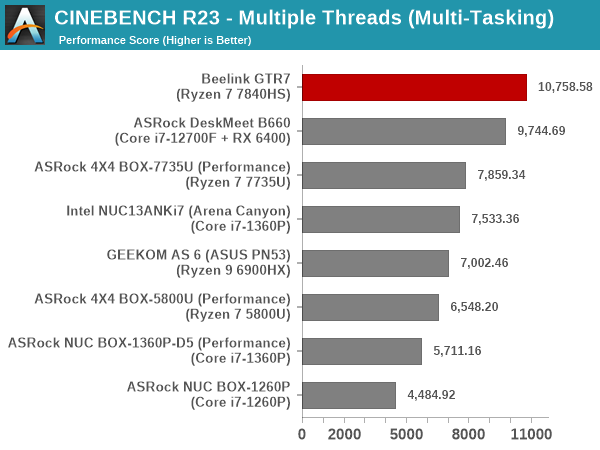
Intensive background tasks keep the efficiency cores busy, and take up some of the power budget. As a result, while the RPL-P systems came out on top in the absence of the background loads in single-threaded mode, the AMD-based systems manages to outwit them in raw scores after the introduction of the load. Multi-threaded performance continues to be a strongpoint of the GTR7, with the system coming out on top irrespective of the concurrent loading.
After the completion of all the workloads, we let the transcoding routine run to completion. The monitored transcoding rate throughout the above evaluation routine (in terms of frames per second) is graphed below.
The transcoding rate during different segments is also recorded below.
| Beelink GTR7 (Ryzen 7 7840HS) ffmpeg Transcoding Rate (Multi-Tasking Test) |
|||
| Task Segment | Transcoding Rate (FPS) | ||
| Minimum | Average | Maximum | |
| Transcode Start Pass | 2.5 | 14.12 | 46.5 |
| PCMark 10 | 0 | 13.99 | 44.5 |
| WebXPRT 4 | 6.5 | 13.63 | 23 |
| Cinebench R23 | 5 | 13.78 | 48.5 |
| Transcode End Pass | 5.5 | 14.8 | 45.5 |
The comparison is against RPL-P systems such as the NUC BOX-1360P/D5. The GTR7 has a much lower delta in the transcoding rate between different task segments, but the power budget ensures that it doesn't translate to a lower primary workload score as seen in the graphs above. Overall, the RPL-P systems seem to prioritize foreground task better compared to AMD systems, but with the right power budget, the end user may not even notice the aspect.


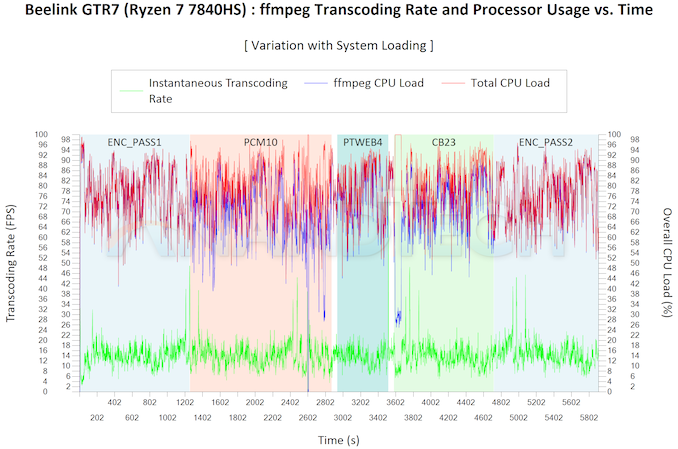








56 Comments
View All Comments
holymaniac1 - Thursday, August 24, 2023 - link
What do you mean? "Windows is unable to present a 4K UI as a result, and the desktop resolution remains fixed at 1080p."Does that mean my PC monitor cannot be full 4K resolution? That's nuts!
ganeshts - Thursday, August 24, 2023 - link
Please re-read the context of that statement - it is when UMA Buffer Size is set to 'Auto'. By default, it is set to 4G by Beelink. In that setting, there is no trouble outputting 4K to the monitor.The statement was made as a feedback for Beelink to ensure that BIOS parameters are labeled in a logical and user-friendly manner.
Oxford Guy - Thursday, August 24, 2023 - link
I hope the Bee in the name isn't about the noise from the fan in this thing. I didn't see any mention of that but perhaps I missed it.mode_13h - Saturday, August 26, 2023 - link
Good question. STH reviewed the same unit and had fairly positive things to say about its noise profile and levels:https://www.servethehome.com/beelink-gtr7-changes-...
Sne4ky - Friday, August 25, 2023 - link
Does anyone have info if it’s support external gpu?And is this desktop or mobile cpu? So later on the cpu can be swapped for another?
meacupla - Friday, August 25, 2023 - link
It can do external GPU over USB4 or NVMe to occulink/PCIe adapterIt's a laptop CPU, and it's not user replaceable.
deil - Friday, August 25, 2023 - link
That puny fan looks like an AliExpress keychain replica of what you really wanted to order.....To be honest they should give you this if you pick 35W TDP and 65W should have raiser and good Noctua slim 120mm fan underneath.
I might seriously consider this, but that fan is seriously under powered for what they put in this box.
meacupla - Friday, August 25, 2023 - link
The fan might be underpowered, but the real issue is the SSD heatsink. It doesn't cover the entire length, and the pads don't make good contact with the controller.I don't think a 120mm would fit. 92mm slim maybe?
I think something like an Airjet cooler would do wonders in here. Particularly with the RAM.
ganeshts - Friday, August 25, 2023 - link
The lower SODIMM stick definitely needs airflow, as seen in the 10C temperature difference in our stress test.As for the SSD, I don't think it is much of a concern because the segment not covered by the heatsink is directly under the system fan - so it gets plenty of airflow.
Could the thermals be better? Absolutely. But, would I trade the fan for an extended SSD heatsink? Probably not, because that would mean sacrificing airflow for the RAM (there is not much place in the internal shroud to place the fan otherwise, without affecting airflow to either the RAM or the SSD).
meacupla - Friday, August 25, 2023 - link
Honestly, I think they should switch over to CAMM. Lower Z height, and don't have to worry about blocked airflow.